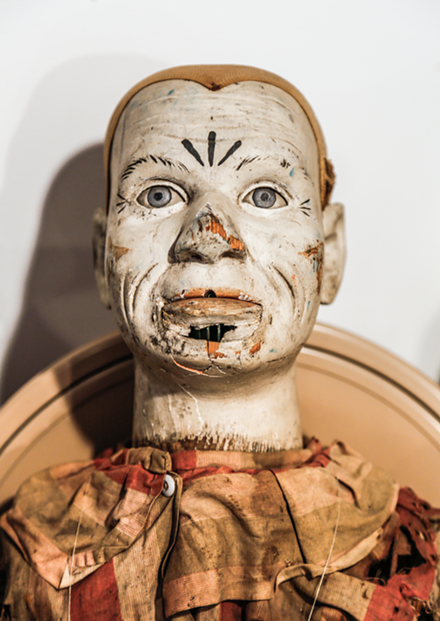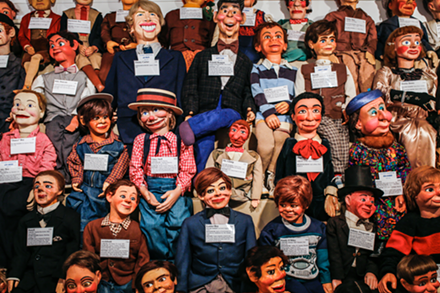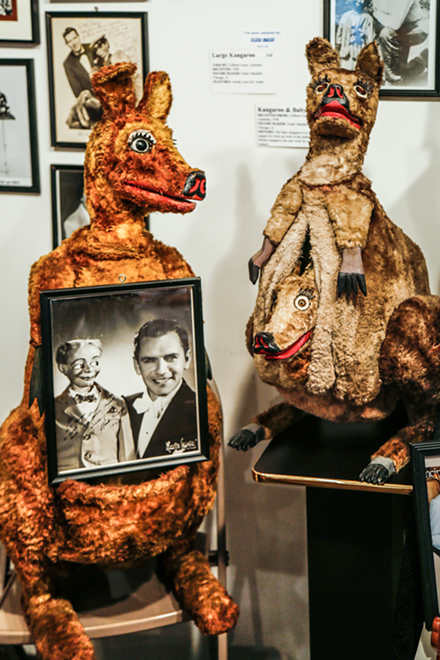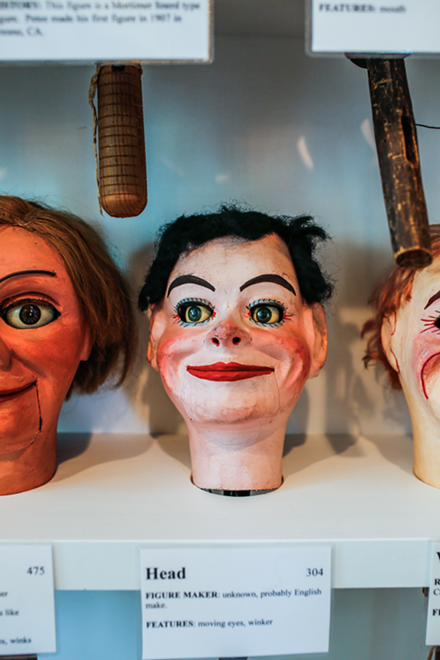The world has just one museum dedicated to the art and history of ventriloquism, and it’s right here in Greater Cincinnati. Fort Mitchell’s Vent Haven Museum is home to 900 (and counting) unique sidekicks, some dating back to the 19th century. They’re joined by an exhaustive collection of ephemera — photos, scripts, posters, recordings and more than 20,000 letters — and archives documenting the art form.
For the uninitiated, ventriloquists use misdirection to “create the impression a voice is coming from somewhere else,” according to the International Ventriloquist Society. Today, that is generally via a puppet-like companion or “dummy.”
The word ventriloquism comes from the Latin “venter,” meaning belly, and “loqui,” meaning speak. Ancient ventriloquists were viewed as religious practitioners who could interpret gastric sounds — assumed to the be the voices of the dead — to prophesize the future.
That thinking evolved in the Middle Ages as people began to incorporate the practice of “throwing” their voice with spiritualism. This led to associations with witchcraft, sorcery and evil before performance artists like stage magicians and circus mystics became a prominent form of entertainment in the 18th century. Traveling ventriloquists were frequently seen onstage during this period talking to invisible friends, creating the illusion of voices manifesting from near and far.
With the advent of vaudeville came the use of dummies to stage witty banter. Stars like Edgar Bergen and his companion, the top-hat-wearing Charlie McCarthy, ushered in the golden age of comedic ventriloquists on radio and TV, paving the way for names like Señor Wences, Paul Winchell, Jimmy Nelson and Shari Lewis (with her pal Lamb Chop).
Modern ventriloquism is an endearing — or slightly unsettling — form of entertainment and you can see both takes in pop culture examples like the creepy Benson ventriloquist doll characters in Toy Story 4 and the Guinness World Record-holding success of comedian/ventriloquist Jeff Dunham. (His 2017 Spark of Insanity tour holds the record for the most tickets sold for a stand-up comedy tour; he also serves on Vent Haven’s board of advisors.)
But regardless of whether you think ventriloquism is an amazing art form or kind of freaky, walking into a room and seeing hundreds of blank faces gazing back isn’t always everyone’s cup of tea — at least not right away.
“People walk into the museum and think, ‘Oh my gosh!’ It’s 900 dummies and so many faces, which, for some people, can be initially off-putting,” says Vent Haven board member and media director Anne Roberts. “But when you hear the stories, you think, ‘Wow, there’s so much more here than I thought.’ ”
Inside the Museum
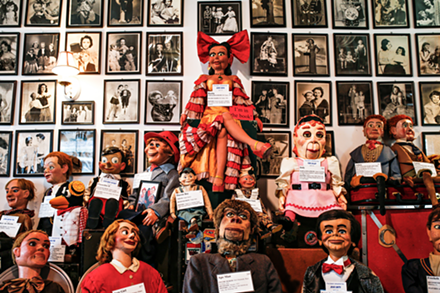
The Vent Haven Museum was founded in 1973 by Cincinnati native William Shakespeare “W.S.” Berger, who spent 40 years collecting dummies, recordings and notes related to ventriloquism.
Although not a ventriloquist himself, Berger was fascinated by it. He lived through what Roberts describes as the first wave of ventriloquism’s popularity “from 1878 to 1972 — essentially vaudeville through Ed Sullivan,” she says.
He bought his first figure, “Tommy Baloney,” in 1910, initially keeping his collection in his Fort Mitchell home. By 1947, he had to renovate a personal garage for additional storage. And in 1962, he built a second structure to help store an estimated 350 dummies.
In 1950, he took over as president of the International Brotherhood of Ventriloquism. He also published a ventriloquism magazine called The Oracle and corresponded with ventriloquists around the world, writing as many as 50 letters per week. All of this contributed to the legacy, community and collection at Vent Haven.
When Berger, who died in 1972, outlived his wife, son and grandson and had no other heirs, he formed a charitable foundation upon the advice of an attorney to prevent his collection from being split up and sold. Roberts was that attorney’s daughter.
“Berger was the first client for my father,” she says. “My dad helped (Berger) transition (Vent Haven) from a personal collection to a private museum, and then was president of the museum for the next 33 years after (Berger) passed away.”
Today, Vent Haven operates as a nonprofit organization on the grounds of Berger’s former residential property and is spread across four buildings, three of which are actively used as part of the museum tour. Although the museum is open only by appointment May 1 through Sept. 30, Vent Haven sees hundreds of visitors each year.
“I give tours almost seven days a week,” says Lisa Sweasy, Vent Haven director and curator.
She notes a growing public curiosity in “the unusual,” that includes locals as much as road trippers and tourists.
“A lot of people come in from overseas, if they’re into puppetry at all, (since) this is the only museum for ventriloquism,” she says.
Vent Haven guests are greeted by a guide upon arrival and enjoy a tour through the buildings rife with colorful faces and memorabilia, usually alongside other often-entranced visitors. Tours are free, but a $10 donation is suggested.
Many of those first-timers arrive with preconceived notions, which board member Roberts is quick to address.
“Before they get to know us, some visitors want to feel like it’s creepy,” she says. “We get that a lot. But for the performers, that’s not their intent at all. The goal of the ventriloquist is to bring the puppet to life. We spend a lot of time saying, ‘The intent is not creepy.’ These are entertainment pieces.
“Every dummy in the museum has a story. The museum is full of great stories of this art form that predates vaudeville, that’s associated with comedy.”
In some rooms at Vent Haven, dummies sit in rows of metal chairs, like in a classroom; in others they are arranged floor to ceiling in bleacher-style seating. Along one wall, there are disembodied heads on rows of shelving. Some standing dummies are behind barriers. Some are encased in glass. But each has a name tag and description telling you who they were used by or who made them, their unique features and their history.
There’s a replica of Charlie McCarthy created from molds of those used by Edgar Bergen. There’s Farfel the dog from the 1950s, who was used in Nestle commercials. And Rosita, a cabaret girl made of balsa wood that a U.S. Naval officer performed with when he was stationed in the Panama Canal during World War II.
Aside from the dummies, ephemera is an important part of the museum.
“There are several sub-collections here,” Sweasy says. “Most of the time, when a dummy comes in, (it arrives) with photographs and a bio, usually it also comes in with a performance script, it comes in with backup costumes.
“We just got, for example, Darci Lynne Farmer’s puppet — she won America’s Got Talent in 2017. She sent us two of her puppets but, in addition to that, she sent us stage passes that she used at AGT, (and) she sent us the dress that she was wearing in the finals.”
Sweasy says adding elements like this make a display much more dynamic. And Farmer’s television appearances have brought a new audience to the world of ventriloquism.
“It’s helped our tourism so much, in regard to children visiting,” Sweasy says.
The ConVENTion
Although ventriloquism isn’t as much a part of the American mainstream as it once was, the art form has still been riding waves of popularity since first finding success in the vaudeville days. After vaudeville theater came radio, film and TV, especially variety shows.
“(But) when Ed Sullivan went off the air, it hurt variety acts of all types — not just ventriloquists,” Sweasy says. “There wasn’t a huge venue anymore where millions of people could see this type of entertainment. Jugglers suffered; magicians suffered. Then, Jeff Dunham exploded. I think that was the beginning of another major wave for us, and it’s really borne out in our tourism and convention numbers for sure.”
Sweasy is talking about the ConVENTion, Vent Haven’s annual ventriloquism gathering that has drawn professional and aspiring ventriloquists from around the world since its inception in 1975. According to board member Roberts, the event draws 500 to 600 attendees annually — not counting the dummies.
“We typically have anything from 15 to 20 countries represented,” she says. “People come from Japan, Germany, England, Australia, South Africa, Israel, Brazil, France, Switzerland and India.”
While the fest draws plenty of seasoned performers, it’s not just for the pros — hobbyists like founder Berger himself to curious enthusiasts are more than welcome.
“We promote (the event) to people who are interested in puppetry, and ventriloquism, and even some of the allied arts, like magic,” Roberts says.
This year’s ConVENTion, which took place July 17-20, included workshops, lectures, open mics, round table conversations and shows. It was headlined by 1991 Star Search winner Taylor Mason.
“Ventriloquism has been an integral part of the show business landscape in movies, television, theater and literature for a couple of centuries,” he says, and acknowledges that it’s become more popular and more requested over the past decade.
For example, ventriloquists won America’s Got Talent in 2007 (Terry Fator), 2015 (Paul Zerdin) and 2017 (Darci Lynne Farmer).
In Mason’s eyes, the ConVENTion has been essential to the survival of the craft. “It’s propelled the art form through some lean times: you couldn’t give away a professional ventriloquist for kid’s parties, much less comedy specials, in the 1980s” he says. “(The ConVENTion) saved the genre from going into the abyss of show business.”
The ConVENTion has even been a part of four different films to date: I’m No Dummy, released in 2009; Dumbstruck, released in 2010; Her Master’s Voice, released in 2012; and The ConVENTion, released in 2012.
Community Building
Aside from the on-site tours and the ConVENTion, community and educational outreach is vital to the nonprofit’s mission.
“We go out into the community (with events like) ‘create your own puppet’ and just talk about puppetry as a communication medium. We continue to showcase the art of ventriloquism and the art of puppet-making” Roberts says, noting that there is a difference between the two.
“In the last five or seven years, we’ve really focused on going out and doing things,” Sweasy adds. “One of the things we do every year is DreamFest at Northern Kentucky University, a day-long festival for elementary and middle school children in the gifted and talented program at their schools.”
Sessions include character development and puppetry, wherein the students make their own puppet.
“We talk about why people respond to puppets in a certain way, what makes a puppet look friendly, or sad,” she says. “They learn about how personality can be reflected in a puppet.”
Sweasy also provides off-site presentations at other schools, libraries, civic group gatherings and nursing homes with the nature of each presentation depending on each group’s familiarity with the art form.
The museum also enjoys a number of frequently returning guests and growing attendance numbers each season.
“As far as the ventriloquists who have been here — Darci Lynne Farmer, Jeff Dunham, Terry Fator — all those people of course have been here multiple times, but then you get magicians, people like David Copperfield who have been here because it’s an allied art and he collects a lot of things that have to do with ventriloquism,” Sweasy says. “Candice Bergen has been here, her father was Edgar Bergen, and she was here as a correspondent when we were on 60 Minutes II. Joel Hodgson has been here a couple of times, the creator of Mystery Science Theater 3000.”
Other notable guests include Linda Bruckheimer, John Davidson and CBS Sunday Morning’s Bill Geist. Vent Haven has also been featured on Good Morning America, in regional press, in Smithsonian Magazine and Sweasy says, “Vice Media was here was last year and they did a piece.”
While the collection, visitors and media attention continue to ramp up, growth is always on the agenda. Roberts says Vent Haven is currently in the middle of a capital campaign to raise money for a new building to host more educational programming.
“We’ve raised or have pledged about $545,000 of our $900,000 goal. We’re really excited about that,” she says. “We’ve been raising money for about two years, and then we’ll build.”
The new structure will help house the ever-increasing collection.
“It’s nearly doubled since the last time we built anything,” Roberts says. “We’ve gone from 500 dummies to almost a thousand.”
Renderings of the new museum building are available on the Vent Haven website (venthaven.org/contribute) and include a gift shop, changing exhibits and lobby while maintaining classic display tactics including the classroom-like set-up featuring dummies in metal chairs and an arena-style two-story exhibit. Another goal of the new space is to maintain the “quiet charm of the museum in its current residential neighborhood,” reads the website
Historical and culturally relevant artifacts are also frequently donated to Vent Haven, and they’re always looking for ways to share the growing collection with guests.
“I get (dummies and puppets donated) almost every week,” Sweasy says.
On tours, she enjoys pointing out new collection pieces to Vent Haven’s frequent guests, whether from Cincinnati or around the world.
“I never know who’s walking down the driveway (next),” she laughs. “I love that about this job.”
The Vent Haven Museum (33 W. Maple Ave., Fort Mitchell) is open May 1-Sept. 30. All tours are guided and by appointment only. For more info, visit venthaven.org.



